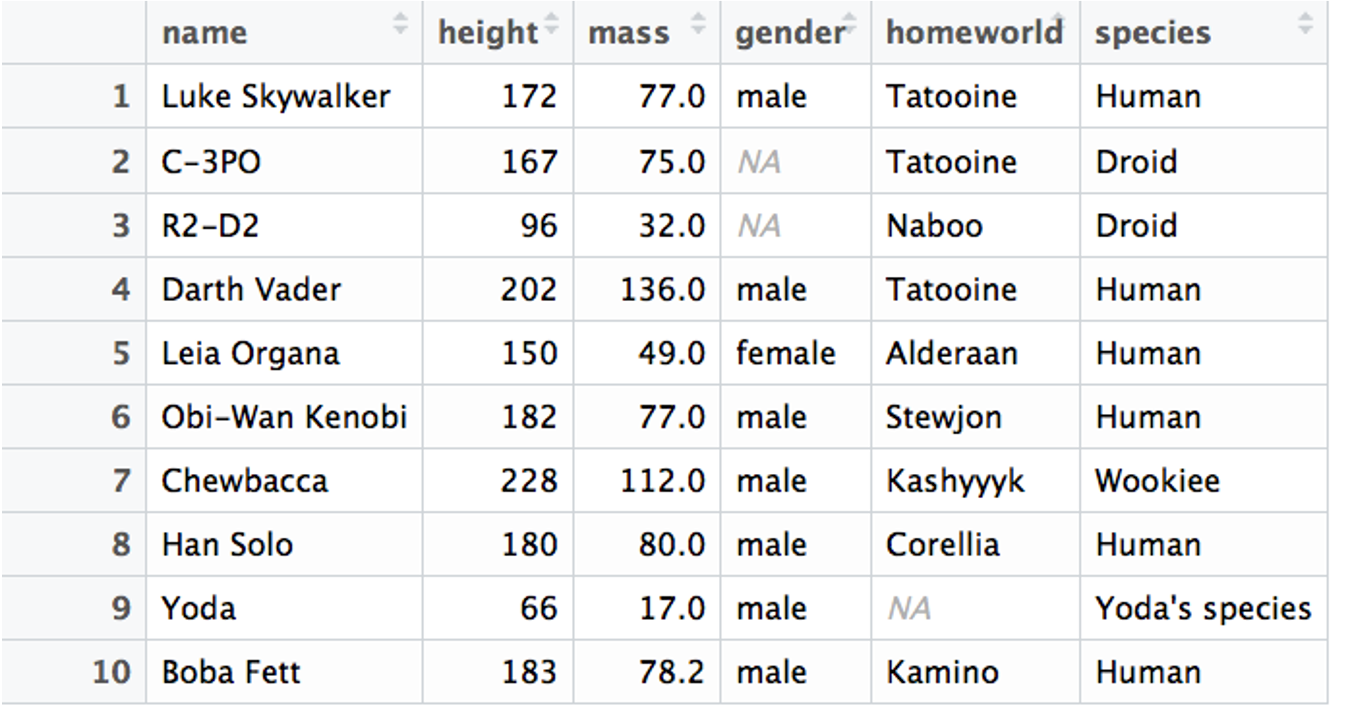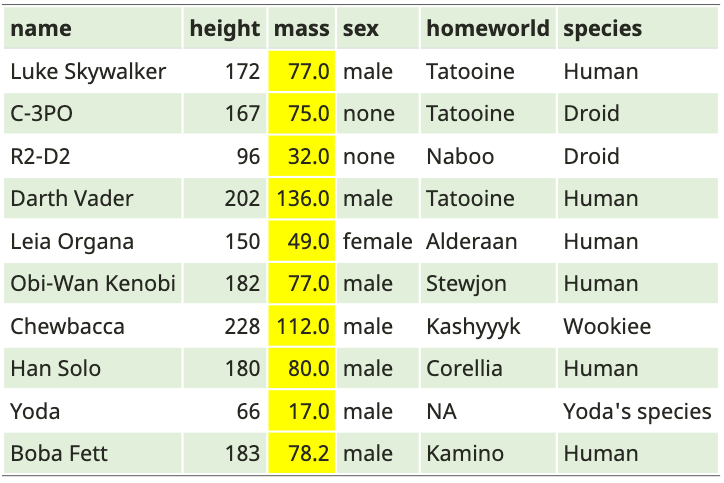Objects & Indexing
Part 2
Plan for today
Recap of objects & classes
More sophisticated objects
- data.frames
- briefly mention others (lists, matrices, tibble)
Objects
Objects are the nouns of programming languages
They have names and they store something
- single value or text string (character)
- vector of objects
- data.frames
- models
- and more
Classes
Objects can be of a different classes. What type of information is stored in the object? Some of the options are:
Classes
Objects can be of a different classes. What type of information is stored in the object? Some of the options are:
- Numeric: Decimals (3.141593)
Classes
Objects can be of a different classes. What type of information is stored in the object? Some of the options are:
- Numeric: Decimals (3.141593)
- Integer: Natural numbers (0,1,2, etc.)
Classes
Objects can be of a different classes. What type of information is stored in the object? Some of the options are:
- Numeric: Decimals (3.141593)
- Integer: Natural numbers (0,1,2, etc.)
- Character: Text or string characters:
- Always inside quotation marks
- Factors (or categories)
Classes
Objects can be of a different classes. What type of information is stored in the object? Some of the options are:
- Numeric: Decimals (3.141593)
- Integer: Natural numbers (0,1,2, etc.)
- Character: Text or string characters:
- Always inside quotation marks
- Factors (or categories)
- Logical: True or False:
- No quotations
- 2 possible values:
TRUEorFALSE - or
T/F... - but NOT
True/False/t/f
Classes
Objects can be of a different classes. What type of information is stored in the object? Some of the options are:
- Numeric: Decimals (3.141593)
- Integer: Natural numbers (0,1,2, etc.)
- Character: Text or string characters:
- Always inside quotation marks
- Factors (or categories)
- Logical: True or False:
- No quotations
- 2 possible values:
TRUEorFALSE - or
T/F... - but NOT
True/False/t/f
- Missing Value:
NA
Data.frames
Another object class is a data.frame. You can think of this as an Excel sheet. empire is an example of a data.frame. When you view it in R, it looks like this:

Data.frames
Typically, this is what we want our data to look like. In empire, we have 6 column vectors. But they are NOT stored as 6 separate objects -- they are combined because they are all related to one another.
Data.frames
Typically, this is what we want our data to look like. In empire, we have 6 column vectors. But they are NOT stored as 6 separate objects -- they are combined because they are all related to one another.
Data.frames are 2-dimensional
Data.frames
Typically, this is what we want our data to look like. In empire, we have 6 column vectors. But they are NOT stored as 6 separate objects -- they are combined because they are all related to one another.
Data.frames are 2-dimensional
- Rows & columns
- Prettier spreadsheet
Data.frames
Every row has 6 pieces of data that are associated with one another...

Data.frames
Every column has 10 observations...

Indexing Data.frames
Data.frames can be indexed just like vectors.
Indexing Data.frames
Data.frames can be indexed just like vectors.
Except: Data.frames have 2 dimensions!
Indexing Data.frames
data.frame[rows, columns]
Indexing Data.frames
data.frame[rows, columns]
What should we get if we typed empire[1:6,5]?
Indexing Data.frames
data.frame[rows, columns]
What should we get if we typed empire[1:6,5]?

Indexing Data.frames
data.frame[rows, columns]
What do we get if we type empire[1:6,5]?
empire[1:6,5]## [1] "Tatooine" "Tatooine" "Naboo" "Tatooine" "Alderaan" "Stewjon"Indexing Data.frames
If you want all of something, leave it blank.
Indexing Data.frames
If you want all of something, leave it blank.
All the rows of column 2
empire[,2]## [1] 172 167 96 202 150 182 228 180 66 183Indexing Data.frames
If you want all of something, leave it blank.
All the rows of column 2
empire[,2]## [1] 172 167 96 202 150 182 228 180 66 183All the columns of row 5
empire[5,]## name height mass sex homeworld species## 5 Leia Organa 150 49 female Alderaan HumanFinding Your Data
Sometimes it's easy enough to remember the row index or column index that you want. But often, we forget!
One of the benefits of a data.frame is that you can access a column by using the column name.
data.frame$column.name
Finding Your Data
empire$height## [1] 172 167 96 202 150 182 228 180 66 183Finding Your Data
empire$height## [1] 172 167 96 202 150 182 228 180 66 183- Note the tab-complete!
Other object types
- Matrix
- Tibble
- List
Matrix
- Very similar to data.frame
- No column names
- No real reason to use matrices
- Can convert to data.frame easily
Matrix
- Very similar to data.frame
- No column names
- No real reason to use matrices
- Can convert to data.frame easily
# Make a matrixtestMatrix <- matrix(data = 1:12, nrow = 4, ncol = 3)testMatrix## [,1] [,2] [,3]## [1,] 1 5 9## [2,] 2 6 10## [3,] 3 7 11## [4,] 4 8 12# Try to access "V1"testMatrix$V1## Error in testMatrix$V1: $ operator is invalid for atomic vectorsMatrix
# Convert to data.frametestDataFrame <- as.data.frame(testMatrix)testDataFrame## V1 V2 V3## 1 1 5 9## 2 2 6 10## 3 3 7 11## 4 4 8 12# Now try to access column 2 using the "V2" headingtestDataFrame$V2## [1] 5 6 7 8Tibble
- Even more similar to a data.frame than matrices are!
- It works particularly well with a suite of packages called the
tidyverse - If you use
class()on a tibble, it might show up astbl_df - At this point, for our purposes, there is not notable difference between a tibble and data.frame.
List
- Contain elements of different types (e.g., numbers, strings, vectors, data.frames, matrices, and more)
- If you store a statistical model as an object, it will likely be in a list format
- Besides dealing with models, we will (for the most part) not be dealing with lists
- But they can be SUPER useful
- Ex: You have 2 large data.frames that have the same variables, but data were collected on different groups (e.g., patients vs. controls). You want to perform the same actions on both datasets. You can store these as a list, and run the same analysis on each, rather than copying/pasting code.
Indexing Lists
- For the most part, you can index lists the same way you would a vector
- (For these examples, let's only look at the first 3 rows of
empire)
exampleList <- list("hello", empire[1:3,], c(2:12))# To get the first element (the word "hello")exampleList[1]## [[1]]## [1] "hello"Indexing Lists
- For the most part, you can index lists the same way you would a vector
- (For these examples, let's only look at the first 3 rows of
empire)
exampleList <- list("hello", empire[1:3,], c(2:12))# To get the second element (the `empire` data.frame)exampleList[2]## [[1]]## name height mass sex homeworld species## 1 Luke Skywalker 172 77 male Tatooine Human## 2 C-3PO 167 75 none Tatooine Droid## 3 R2-D2 96 32 none Naboo DroidIndexing Lists
- For the most part, you can index lists the same way you would a vector
- (For these examples, let's only look at the first 3 rows of
empire)
exampleList <- list("hello", empire[1:3,], c(2:12))# To get the third element (the vector of numbers 2 through 12)exampleList[3]## [[1]]## [1] 2 3 4 5 6 7 8 9 10 11 12Indexing Lists
- BUT! Lists have the equivalent of an empty book page that says "Chapter 2" before getting to the actual chapter.
- In order to open the chapter, we use double brackets
[[ ]]
# Single bracketsexampleList[2]## [[1]]## name height mass sex homeworld species## 1 Luke Skywalker 172 77 male Tatooine Human## 2 C-3PO 167 75 none Tatooine Droid## 3 R2-D2 96 32 none Naboo Droid# Single brackets doesn't get you "in"exampleList[2]$mass## NULLIndexing Lists
- BUT! Lists have the equivalent of an empty book page that says "Chapter 2" before getting to the actual chapter.
- In order to open the chapter, we use double brackets
[[ ]]
# Single bracketsexampleList[2]## [[1]]## name height mass sex homeworld species## 1 Luke Skywalker 172 77 male Tatooine Human## 2 C-3PO 167 75 none Tatooine Droid## 3 R2-D2 96 32 none Naboo Droid# Double bracketsexampleList[[2]]## name height mass sex homeworld species## 1 Luke Skywalker 172 77 male Tatooine Human## 2 C-3PO 167 75 none Tatooine Droid## 3 R2-D2 96 32 none Naboo DroidIndexing Lists
- BUT! Lists have the equivalent of an empty book page that says "Chapter 2" before getting to the actual chapter.
- In order to open the chapter, we use double brackets
[[ ]]
# Double bracketsexampleList[[2]]## name height mass sex homeworld species## 1 Luke Skywalker 172 77 male Tatooine Human## 2 C-3PO 167 75 none Tatooine Droid## 3 R2-D2 96 32 none Naboo Droid# Double brackets gets you "in"exampleList[[2]]$mass## [1] 77 75 32